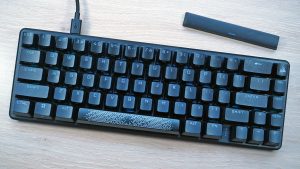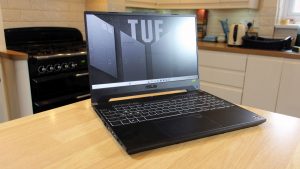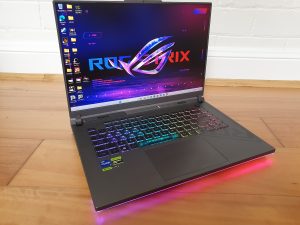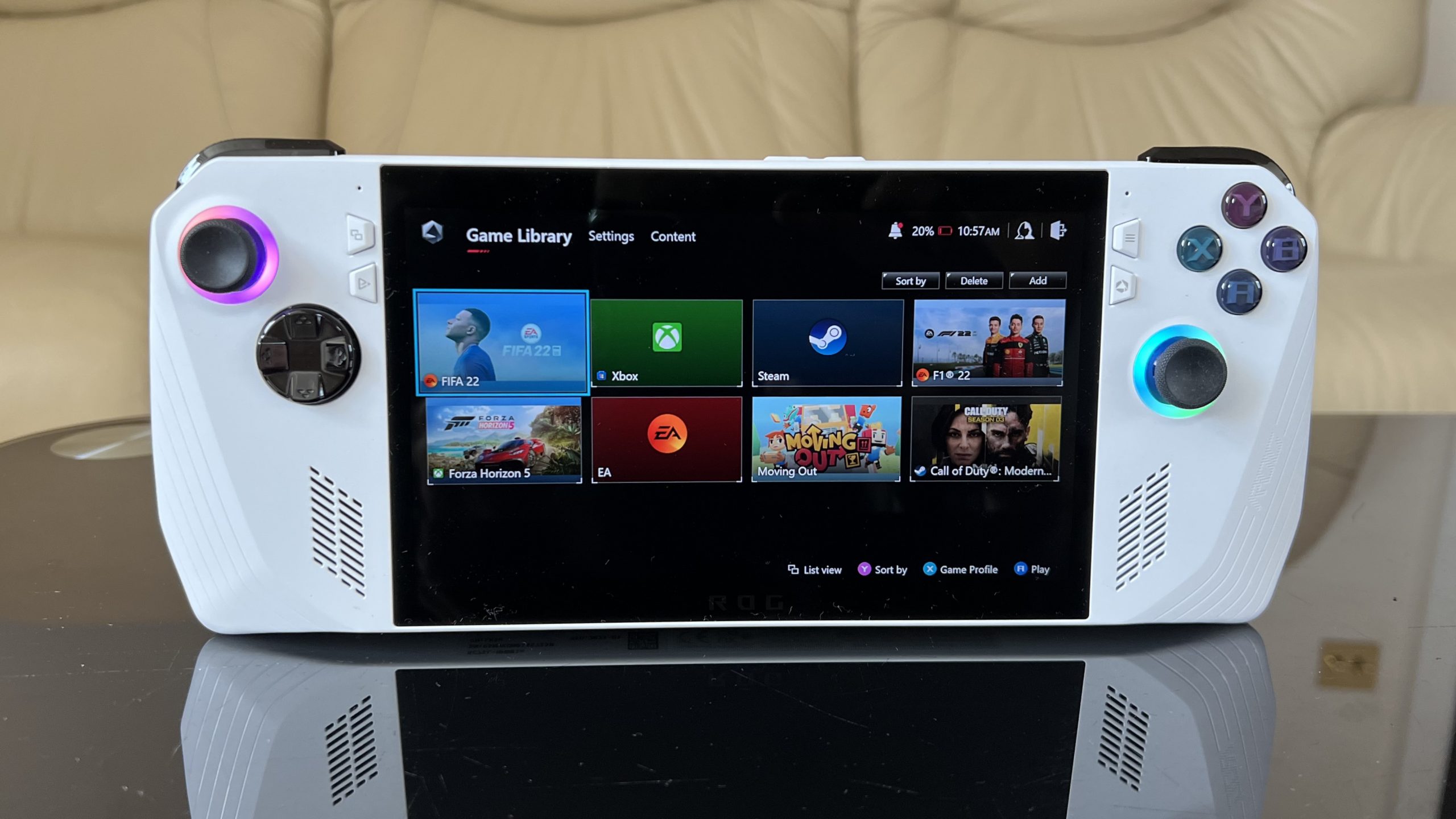
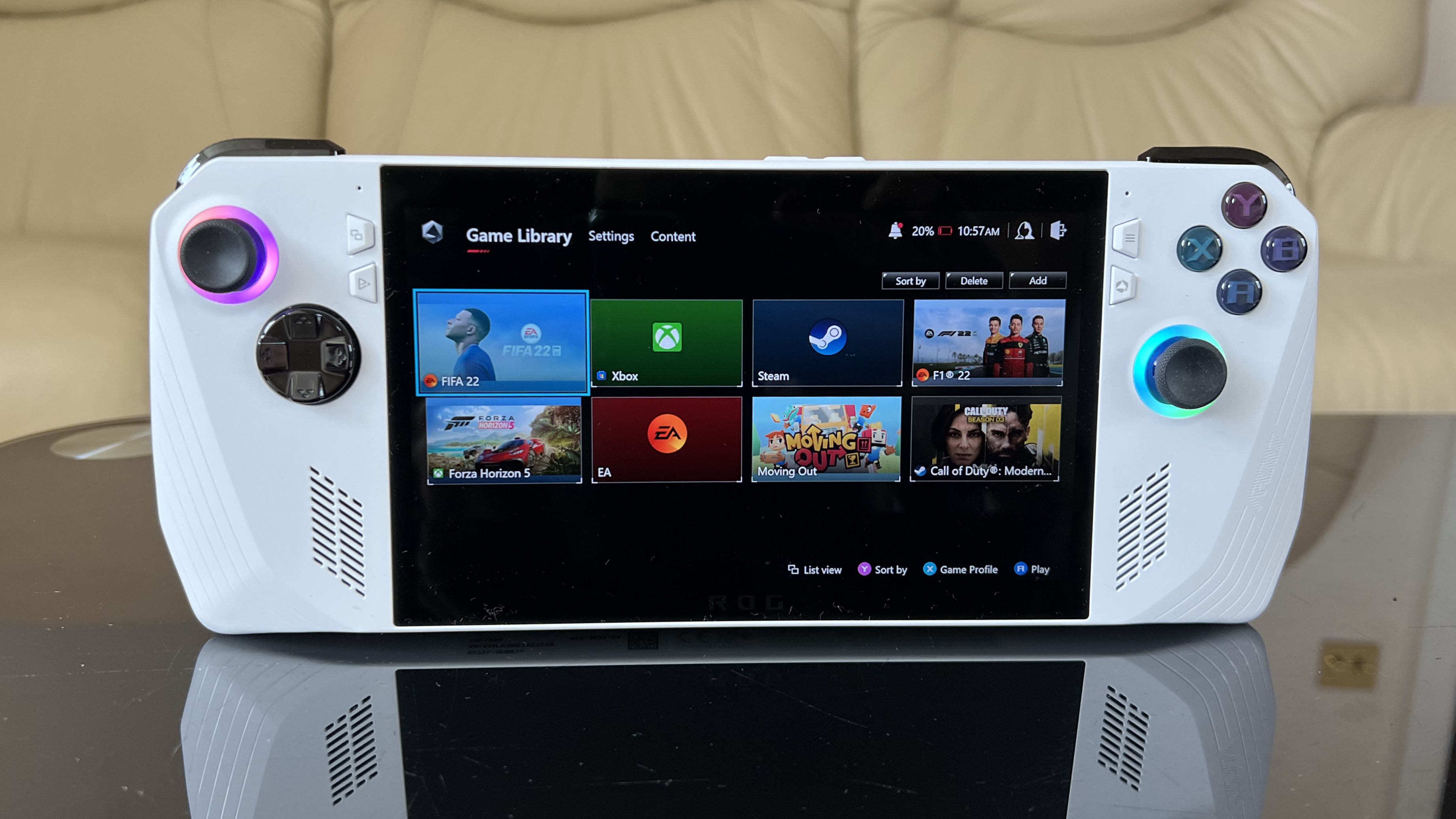
Handheld consoles have actually been around because the late 1980s, but it recently feels like we’ve gotten in a new period with home console gaming coming to portable devices.
From the Nintendo Switch being the only reasonable choice for such handheld quality a couple of years back, we now have reliable rivals from the likes of Valve, Logitech and Onex. These are consoles that do not play standard physical video game cartridges, cards, or discs, but rather stream or download games from services such as Steam or Xbox Game Pass.
But with the ROG Ally, Asus wishes to take things to the next level. Unlike competitors, it runs a complete variation of Windows 11, implying you can play the exact same series of video games as any PC. Along with devoted AMD flagship processors and a 120Hz display, Asus implies business.
Does it live up to the hype, and more significantly, that high rate? I believe so, however just if you’re willing to completely accept the portable type aspect and its compromises.
Design & develop
Premium but large design
Excellent Xbox-style controls
Good series of ports
The ROG Ally is a genuine declaration of intent from Asus, which begins with design. It’s a large, enforcing gadget with an unique video gaming aesthetic, yet still feels slick enough to have traditional appeal. I’m not extremely into modern-day gamer aesthetic appeals, however have no issue using this in public.
A reasonably lightweight of 608g and density of 21.2 mm are a huge selling point of the Ally, indicating you can take it nearly anywhere with you. For context, that’s thinner and lighter than the Valve Steam Deck, despite both devices having a 7in screen.
Most importantly for such a pricey device, the premium look and feel isn’t jeopardized to get there. The white finish will not be to everybody’s tastes, but I feel it adds to a style that’s streamlined and contemporary. If you’ve used the white Nintendo Switch OLED, you’ll understand what I mean.
As great as it looks, though, an alternative colour choice would’ve been great. The gadget does an excellent job of avoiding choosing up visible dirt marks, something I was concerned about.
While the style of the Ally is fairly generic, Asus has actually still handled to put its own stamp on the gadget. Small ROG-specific touches can be discovered across the device, from a big logo on the back to RGB lighting around both joysticks. The latter can quickly end up being frustrating, particularly if you leave it on the default ‘rainbow’ mode, however this can quickly be personalized or shut off completely.
The joysticks themselves are where my thumbs naturally rest, offering a comfortable experience. My only complaint is the lack of padding, which can end up being uneasy when making lots of fast movements.
Asus has chosen Xbox-style ABXY buttons in the top-right corner, plus a directional pad diagonally opposite. Both are clicky and responsive, making them easy to press no matter the game.
Triggers and bumpers on the top of the Ally are simply as good, however Asus has added a few extra physical buttons of its own. The most noteworthy are 2 on the back of the gadget, which the company is calling ‘Macro 1’ and ‘Macro 2′. While not appropriate in numerous video games, one-tap access to functions of your option can make a huge difference in some titles. It’s certainly a nice option to have.
Faster ways to the View, Command Center, Armoury Crate and Menu areas on the front of the device are more mundane, but still worth having. Integrated, the physical buttons and joysticks deliver a more convincing experience than even a dedicated controller
The physical buttons and joysticks provide a more convincing experience than even a devoted controller.
At the top, the power button doubles as a fingerprint sensor, which is a cool addition. It’s rather little, but still reasonably fast and trustworthy. Beside it, you’ll discover volume controls and a surprisingly great port choice.
Together with a USB-C port for charging, you get a microSD slot for expandable storage, a 3.5 mm audio jack, and devoted connector for ROG XG Mobile, Asus’ external GPU system.
The latter can supposedly deliver a huge increase to the already exceptional efficiency, however I wasn’t sent out one to test out. It also costs well over $1,000/ ₤ 1,000 and makes the Ally much less portable. For the vast majority of people, it’s completely unneeded.
Screen & speakers
7in, Full HD display screen
120Hz refresh rate
Excellent dual speakers
The display on the ROG Ally is one of its crucial strengths. It’s a 7in, Full HD (1920 × 1080) IPS touchscreen, total with Gorilla Glass Victus for additional resilience. That resolution gives it a timeless 16:9 aspect ratio, implying nearly all games can run natively.
It’s a real action up from the Steam Deck and Nintendo Switch OLED, which are both restricted to 720p output. You likewise get a 120Hz refresh rate on the Ally, rather than the basic 60Hz on the other devices.
With all that in mind, it’ll come as not a surprise to discover that the screen here is a happiness to utilize. Gameplay looks superb, with rich, dynamic colours and lots of detail. On a screen of this size, you definitely don’t need a greater resolution.
When packing up a video game for the very first time, I was genuinely shocked by how excellent the screen looked It’s not rather high-end PC or television console level, but it’s not far off. This is a premium display screen.
Prior to screening, I was concerned about how the LCD panel here would compare to OLED. However darker colours and contrast are still remarkable on the ROG Ally, and it does not seem like you’re losing out.
When filling up a video game for the very first time, I was truly stunned by how excellent the screen looked.
The display’s 7ms action time isn’t the greatest by PC video gaming requirements, however there was no noticeable input lag while playing. Only devoted players will observe any difference compared to more responsive screens.
Offered how portable the Ally is, you may wish to utilize it outside. A maximum brightness of 502 nits suggests that’s quite possible.
My only problem here is the bezels, which are much thicker than they need to be. There’s a ROG logo listed below the screen, but no web cam at the top– there’s no camera at all. This is a shame. Unlike a tablet, there’s lots of area to conveniently hold the device already, so Asus has no real reason for not squeezing one in.
However, the ROG Ally does gain from double stereo speakers, which produce noise from both the front and back of the gadget. The room-filling audio they supply is solid, thinking about the size of the gadget, with a remarkable depth to music and sound effects.
In-game character voices sound crystal-clear too, though an additional hit of bass and higher max volume would be great. For the very best experience, you’ll still need to connect earphones– whether they’re wired (via the 3.5 mm jack) or cordless (through Bluetooth).
Specifications & gaming performance
AMD Ryzen Z1 and Radeon graphics
Superb, console-level efficiency
Limited storage, but microSD expansion
Asus has actually made a big deal of the performance capabilities of the ROG Ally, and it’s simple to see why.
The gadget is powered by the Ryzen Z1 Series, brand-new AMD chips that are specifically developed for portable consoles. Asus claims both Ryzen Z1 and Z1 Extreme models provide flagship-level performance, but just the latter is concerning the UK– it’s the version I’ve been checking.
Asus ROG Ally – essential specs
The resolution can be increased to 1920 × 1080 in Settings
Anyron Copeman/ Foundry
While integrated AMD Radeon graphics and 16GB of DDR5 RAM (on both models) doesn’t sound particularly impressive, the results are. Performance is excellent, and in line with inexpensive gaming laptops in the ₤ 600- ₤ 800 cost variety– as the standards listed below program:
Crucially, that’s shown in real-world use. I attempted some of the most requiring PC video games you can play, across 3 of the most popular platforms: Xbox Game Pass, EA Play and Steam. Whatever runs really efficiently at 1080p, with gameplay looking excellent on the ROG Ally’s excellent screen.
It’s not quite as good as a full PC gaming rig or next-gen console, but you won’t be disappointed by the efficiency on offer here. There are no visible dropped frames, even during fast-paced action video games. According to Asus, a June 2023 upgrade apparently increases framerates by around 10-20%, boosting performance even further.
Doubts and lag aren’t a concern while playing games, and bugs somewhere else appear related to software application rather than hardware. I highly doubt more power would alter anything, and it’s worth enduring them for the exceptional in-game performance.
One feature which can sometimes be neglected is the vibration motor. It’s excellent here, providing subtle feedback that really boosts the gaming experience.
Whatever runs very smoothly at 1080p, with gameplay looking outstanding
After only a number of minutes of playing, there was a noticeable build-up of heat. The advanced cooling system means the Ally only ever gets warm to the touch, with both fans on the back of the device where they will not be covered by your hands. Even when in full flow, they do not get too loud– Asus claims a maximum of just 20dB.
Unlike the Nintendo Switch, you have to keep the ROG Ally in one piece at all times. The controllers aren’t removable, although you do have the alternative to link it to a television or display via HDMI.
It works seamlessly, with fantastic picture quality and no drop in efficiency. But the feature depends on the ROG Gaming Charger Dock, which costs ₤ 60 additional in the UK. Just consisting of an HDMI port on the device itself would’ve resolved this problem.
This isn’t a terrific method to game however, as hotspotting to a phone is not a fast method to stream video games and is not a method I recommend relying on. If you want to stream games, this is just realistically possible on great Wi-Fi.
The upcoming Android-based Razer Edge has a 5G alternative, but that gadget is much less effective than the ROG Ally.
The ROG Ally Z1 variation consists of a 256GB SSD, while the Z1 Extreme design I evaluated boosts that to 512GB. With around 54GB taken up by Windows system files, it does not leave much room for video games.
Even with only five video games installed, I got a pop-up message saying inadequate storage when trying to download a 6th. A lot of titles I played, consisting of FIFA 22, F1 22 and Call of Duty: Warzone, were between 50-100GB. However some– such as Forza Horizon 5– were considerably higher. Fortunately, the storage capability can be expanded by means of microSD, but it’s another separate purchase.
Software application
Runs Windows 11 Home
Access to complete variety of PC games
Great deals of software bugs
An essential advantage of the ROG Ally compared to other portable consoles is software. It runs a complete variation of Windows 11 Home, implying you have full access to the same series of games as a PC. You can use several different game services, and you aren’t connected to one business’s.
The great benefit of the ROG Ally is you can stream games if you go by means of a cloud gaming service, or play utilizing on-device downloads. It’s finest with the latter, but having the alternative is a luxury.
Whether you utilize Steam, Xbox Game Pass, the Epic Games Store or perhaps a cloud video gaming service, they’ll all work on the ROG Ally. All your downloaded games can be accessed by means of the Armoury Crate SE app, which opens by default when you turn on the gadget.
It serves as a simple app launcher, however likewise a hub for the extensive customisation options available. You can change controls, efficiency, lighting, display and audio, the majority of which can likewise be accessed via the dedicated Command Center button mid-game.
You will need to make certain the gamepad is selected for many video games, with keyboard and mouse frequently set as the default. However changing all these settings feels slick and intuitive.
Unfortunately, the exact same can’t be stated for the rest of the Windows 11 experience Microsoft’s operating system isn’t optimised to operate on this kind of hardware, and it reveals.
I encountered lots of bugs and issues throughout my testing time, from app crashes and stuttering to video games that simply declined to display in full screen. On a couple of events, the screen wouldn’t switch on at all.
All of these were dealt with within a couple of minutes, but it’s frustrating to encounter them so regularly. As good as the video gaming is, software application bugs seem part and parcel of the ROG Ally experience at launch. I might repair every bug by closing or minimising other apps and restarting software application, however it was very frustrating.
As excellent as the video gaming is, software application bugs are part and parcel of the ROG Ally experience.
The benefits of Windows 11 can simply about outweigh the drawbacks. You will simply need to be patient when filling video games.
Battery life & charging
40Wh battery
Less than two hours of video gaming per charge
Quick 65W charging
Battery life is the greatest factor not to purchase the ROG Ally. It has a 40Wh cell, but plainly that’s not huge enough for 1080p video gaming on a 120Hz screen.
I totally charged the gadget prior to each video gaming session, yet would always strike 0% in less than 2 hours. It didn’t matter which video game I played– all AAA titles deplete the battery very quickly.
This is rather to be expected given the size of the battery and the power required to drive PC-level gaming. This console can’t even last a short haul flight prior to needing a charge, which defeats the point– and the pleasure– if video gaming on the go.


